
Hieracium , known by the common name hawkweed and classically as hierakion, is a genus of flowering plant in the family Asteraceae, and closely related to dandelion (Taraxacum), chicory (Cichorium), prickly lettuce (Lactuca) and sow thistle (Sonchus), which are part of the tribe Cichorieae. Hawkweeds, with their 10,000+ recorded species and subspecies, do their part to make Asteraceae the second largest family of flowering plants. Some botanists group all these species or subspecies into approximately 800 accepted species, while others prefer to accept several thousand species. Since most hawkweeds reproduce exclusively asexually by means of seeds that are genetically identical to their mother plant, clones or populations that consist of genetically identical plants are formed and some botanists prefer to accept these clones as good species whereas others try to group them into a few hundred more broadly defined species. What is here treated as the single genus Hieracium is now treated by most European experts as two different genera, Hieracium and Pilosella, with species such as Hieracium pilosella, Hieracium floribundum and Hieracium aurantiacum referred to the latter genus. Many members of the genus Pilosella reproduce both by stolons and by seeds, whereas true Hieracium species reproduce only by seeds. In Pilosella, many individual plants are capable of forming both normal sexual and asexual (apomictic) seeds, whereas individual plants of Hieracium only produce one kind of seeds. Another difference is that all species of Pilosella have leaves with smooth (entire) margins whereas most species of Hieracium have distinctly dentate to deeply cut or divided leaves.
A dry roadside dotted with small, ¾ inch red orange flowers, interspersed with very similar yellow ones, and often the white of daisies, is a good sign that you are in Hawkweed country.

Pilosella officinarum, known as mouse-ear hawkweed, is a yellow-flowered species of flowering plant in the daisy family Compositae, native to Europe and northern Asia. It produces single, lemon-coloured inflorescences. Like most hawkweed species, it is highly variable and is a member of a species complex of several dozens of subspecies and hundreds of varieties and forms. It is an allelopathic plant.

Hieracium albiflorum, known by the names white hawkweed and white-flowered hawkweed, is a common and widespread species of plant in the family Asteraceae.
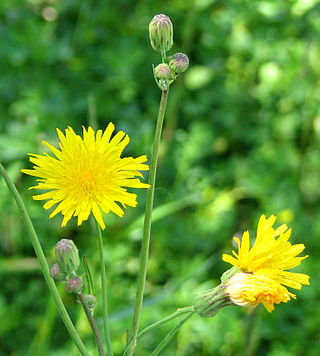
Hieracium umbellatum, the Canadian hawkweed, Canada hawkweed, narrowleaf hawkweed, or northern hawkweed, is a flowering plant in the family Asteraceae.

Hieracium lachenalii, also known as common hawkweed or yellow hawkweed, is a species of plant in the tribe Cichorieae within the family Asteraceae. It is native to Europe but has become established as a weed in Australia and parts of North America.

Pilosella caespitosa is like several other Pilosella species and has a similar appearance to many of the hawkweeds.
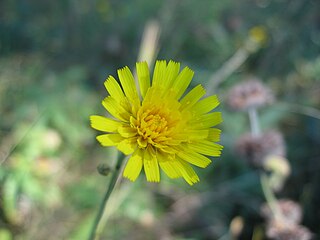
Hieracium sabaudum, also known as New England hawkweed, European hawkweed or a Savoy hawkweed, is a European species of plants in the tribe Cichorieae within the family Asteraceae. It is native to Europe but has become naturalized in parts of North America. In Canada, it grows in British Columbia, Québec, and Nova Scotia. In the United States, it has been found in Washington state in the Northwest as well as Wisconsin and the Northeast. The species is considered a noxious weed in Washington state.
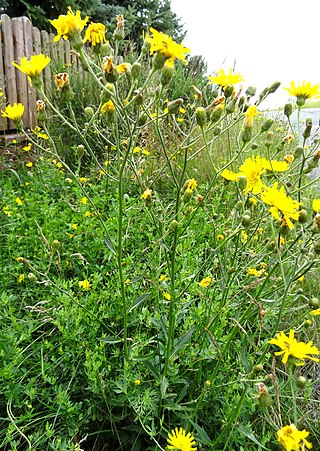
Hieracium laevigatum, or smooth hawkweed, is a Eurasian plant species in the tribe Cichorieae within the family Asteraceae. It is widespread across much of Europe and western Asia. It is very similar to Hieracium sabaudum and can be found on dry, more or less nutrient rich soil in light woods, grassy embankments and fields, or on walls.
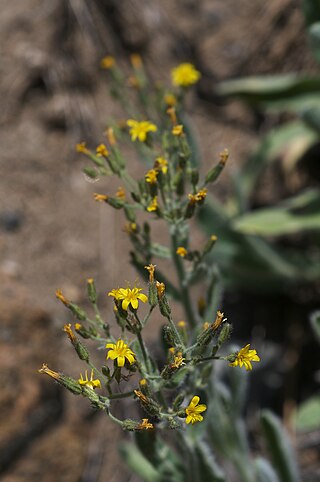
Hieracium horridum, known as the prickly hawkweed or shaggy hawkweed, is a species of plant in the family Asteraceae. It gets its name from the long, dense, shaggy white to brown hairs (trichomes) which cover all of the plant parts of this plant species. The species is native to Oregon, California, and Nevada in the western United States.
Hieracium greenei is a species of hawkweed known by the common name Greene's hawkweed.

Hieracium scouleri, known as Scouler's woollyweed, is a species of flowering plant in the tribe Cichorieae within the family Asteraceae. It is native to western North America, from British Columbia and Alberta in Canada, and south to northern California and Utah in the United States.

Oxyptilus pilosellae is a moth of the family Pterophoridae first described by Philipp Christoph Zeller in 1841. It is found in most of Europe, east to Russia and Asia Minor. It was released as a biological control agent for Hieracium in New Zealand in 1998.
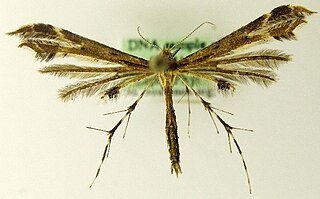
Oxyptilus chrysodactyla is a moth of the family Pterophoridae. It is found in most of Europe, except most of the Balkan Peninsula, Great Britain, Ireland and Portugal.

Hieracium venosum is a species of hawkweed in the tribe Cichorieae within the family Asteraceae. It is widespread and common in south-central Canada (Ontario) and the eastern United States. Its common name comes from the fact that environments it is found in are typically also a home to rattlesnakes.
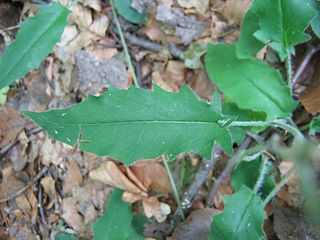
Hieracium murorum, the wall hawkweed, is a species of flowering plant in the family Asteraceae. It is native to Europe and naturalized in some of the colder regions of North America.

Hieracium triste, commonly known as woolly hawkweed, is a species of flowering plant. It is native to North America where it is widespread across western Canada and the western United States from Alaska, Yukon, and the Northwest Territories south as far as California and New Mexico.
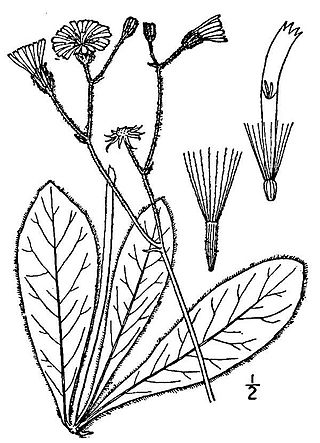
Hieracium traillii is a species of hawkweed known by the common name Maryland hawkweed.

Hieracium gronovii, commonly known as queendevil, hairy hawkweed, beaked hawkweed, and Gronovius' hawkweed, is a North American plant species in the tribe Cichorieae within the family Asteraceae. It is common and widespread across much of the continent from Ontario south as far as Florida, the Dominican Republic, and Panamá. The plant can be found in rocky, dry, open woods and in fields.

Hieracium scabrum, commonly known as rough hawkweed or sticky hawkweed, is a North American plant species in the tribe Cichorieae within the family Asteraceae. It is native to the eastern and central United States and Canada.

Hieracium schultzii, the roughstem hawkweed, is a species of plant in the tribe Cichorieae within the family Asteraceae. It is widespread across much of Mexico with a few populations in Guatemala and western Texas.

















